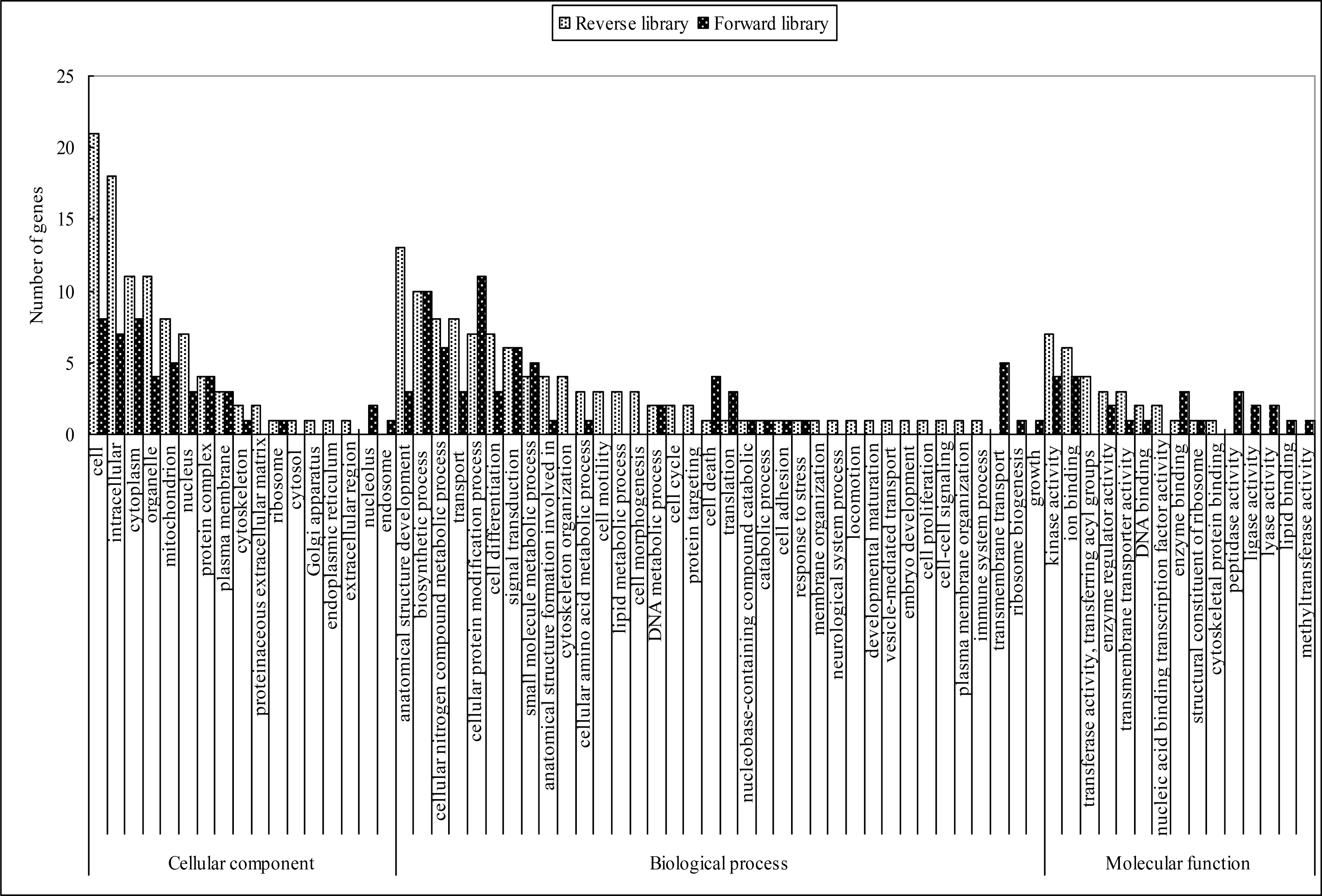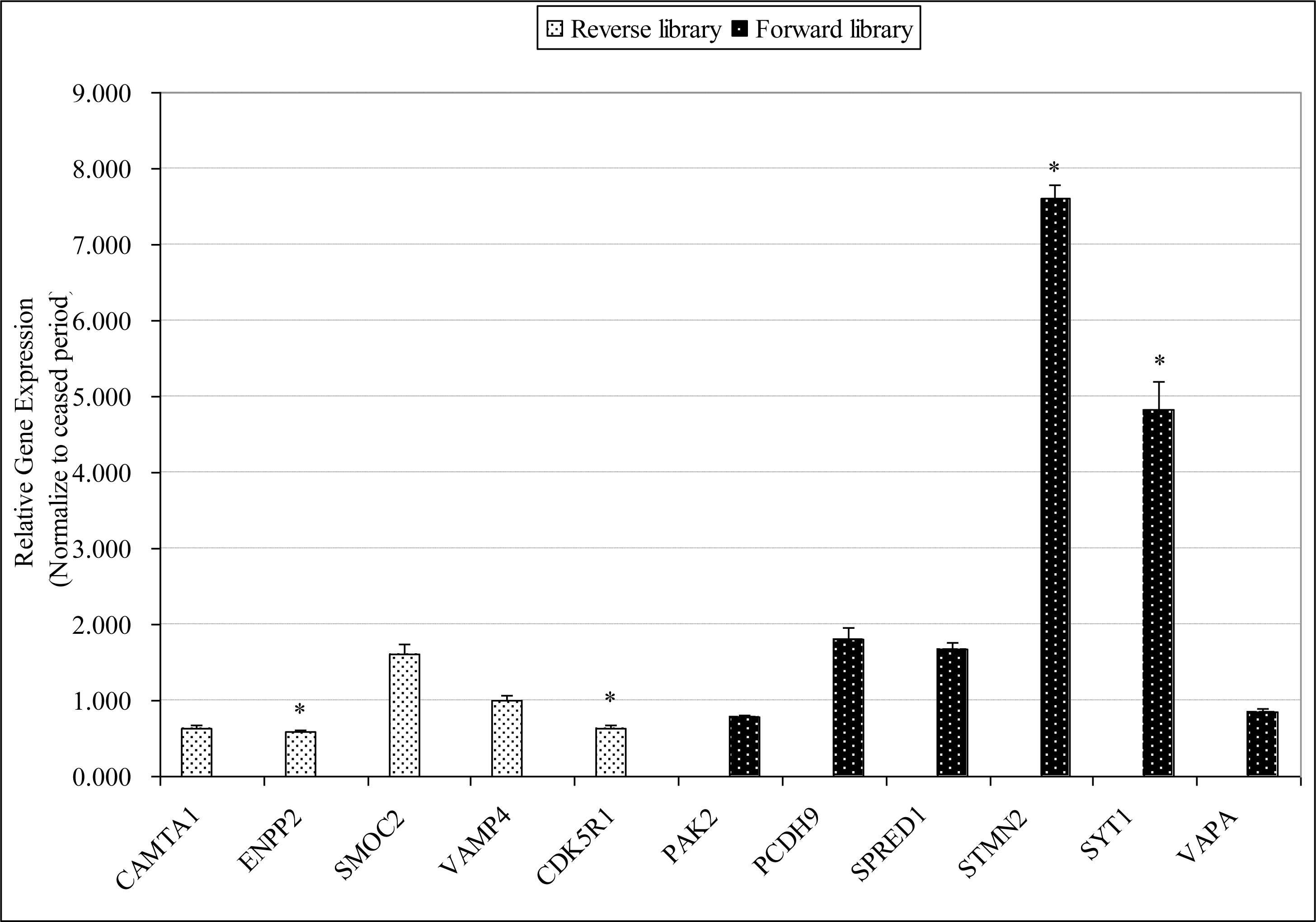 |
 |
Abstract
ACKNOWLEDGMENTS
Figure 1.

Figure 2.

Table 1.
Table 2.
| NCBI BLAST gene name | Accession number1 | Species | E-value2 |
|---|---|---|---|
| Contactin associated protein-like 2 (CNTNAP2) | NM_001193337.1 | Taeniopygia guttata | 3.00E-23 |
| P21 protein (Cdc42/Rac)-activated kinase 2, transcript variant 2 (PAK2) | XM_422671.2 | Gallus gallus | 1.00E-92 |
| Phytanoyl-CoA 2-hydroxylase interacting protein-like (PHYHIPL) | NM_001199504.1 | Gallus gallus | 1.00E-97 |
| Solute carrier family 5 (sodium/glucose cotransporter), member 11 (SLC5A11), | XM_414862.3 | Gallus gallus | 0.000006 |
| Serine/arginine-rich splicing factor 3 (SRSF3), | NM_001195554.1 | Gallus gallus | 2.00E-171 |
| Legumain (LGMN) | XM_421328.3 | Gallus gallus | 2.00E-84 |
| Stathmin-2-like (STMN2) | XM_003205132.1 | Meleagris gallopavo | 2.00E-75 |
| O-linked N-acetylglucosamine (GlcNAc) transferase (UDP-N-acetylglucosamine:polypeptide-N-acetylglucosaminyl transferase) (OGT) | NM_001006317.2 | Meleagris gallopavo | 0 |
| Glutamate-ammonia ligase (GLUL) | NM_205493.1 | Gallus gallus | 8.00E-109 |
| Cytochrome c oxidase subunit I (COX1) gene, mitochondrial | GU179002.1 | Anser | 6.00E-170 |
| Cytochrome c oxidase subunit III (COX3) gene, mitochondrial | GU179010.1 | Anser | 0 |
| Synaptotagmin-1-like SYT1 | XM_003202102.1 | Meleagris gallopavo | 0.0003 |
| Ribosomal protein, large, P0 (RPLP0) | NM_204987.1 | Gallus gallus | 1.00E-171 |
| Poly(A) binding protein interacting protein 2 (PAIP2) | NM_001007832.1 | Gallus gallus | 8.00E-109 |
| Minichromosome maintenance complex component 6 (MCM6) | NM_001006527.1 | Gallus gallus | 7.00E-150 |
| Sprouty-related, EVH1 domain containing 1 (SPRED1), | NM_152594.2 | Homo sapiens | 2.00E-49 |
| Protocadherin 20 (PCDH20) | XM_003980439.1 | G | 8.00E-14 |
| Protocadherin 9 (PCDH9) | XM_003640560.1 | Gallus gallus | 0 |
| Vesicle-associated membrane protein-associated protein A-like (VAPA) | XM_003204959.1 | Meleagris gallopavo | 0 |
| Solute carrier family 4, sodium bicarbonate cotransporter, member 4, (SLC4A4) | XM_003641192.1 | Meleagris gallopavo | 1.00E-161 |
| ATP synthase, H+ transporting, mitochondrial F1 complex, O subunit (ATP5O) | XM_416717.3 | Meleagris gallopavo | 0 |
| Four and a half LIM domains 2 (FHL2), | XM_416924.3 | Meleagris gallopavo | 1.00E-112 |
| Major facilitator superfamily domain containing 2A (MFSD2A) | XM_417826.3 | Meleagris gallopavo | 0.0001 |
| SDA1 domain containing 1 (SDAD1) | XM_420597.3 | Meleagris gallopavo | 0.0005 |
| Anser albifrons mitochondrion, complete genome | AF363031.1 | Anser | 7.00E-170 |
| anser clone goosePiSSHFmixIB05 pituitary gland-expressed unknown gene 8 mRNA sequence | DQ836037.1 | Anser | 8.00E-55 |
| Voucher BISE-Aves24 cytochrome oxidase subunit 1 (COI) gene,mitochondrial | GU571728.1 | Anser anser | 6.00E-165 |
| Meleagris gallopavo myelin proteolipid protein-like | XM_003205647.1 | Meleagris gallopavo | 0 |
| Chondroitin polymerizing factor 2 (CHPF2), | XM_003214253.1 | Meleagris gallopavo | 2.00E-178 |
| Reticulon 4 (RTN4) | XM_003640893.1 | Gallus gallus | 3.00E-143 |
1 Accession numbers are from the National Center for Biotechnology Information (NCBI) nonredundant nucleotide database.
2 Expected (E) value is a parameter when searching a sequence of particular size in a database (http://www.ncbi.nlm.nih.gov/BLAST/tutorial/Altschul-1.html). It is used to test the hypothesis of a random match to the bases in the database, the closer the E-value to zero, the lower the possibility of mistake in a gene identity.
Table 3.
| NCBI BLAST gene name | Accession number1 | Species | E-value2 |
|---|---|---|---|
| Muscleblind-like 3 (Drosophila) (MBNL3), transcript variant 1 | NM_001163338.1 | Gallus gallus | 0.00E+00 |
| NADH dehydrogenase (ubiquinone) 1 alpha subcomplex, 4 (NDUFA4) | XM_001234600.2 | Gallus gallus | 7.00E-148 |
| N(alpha)-acetyltransferase 20, NatB catalytic subunit (NAA20) | XM_422177.3 | Gallus gallus | 5.00E-57 |
| Solute carrier family 1 (glial high affinity glutamate transporter), member 3 (SLC1A3) | XM_425011.2 | Gallus gallus | 0 |
| Ectonucleotide pyrophosphatase/phosphodiesterase 2 (ENPP2) | NM_001198662.1 | Gallus gallus | 8.00E-110 |
| Nuclear factor I/B (NFIB), transcript variant 2 | NM_001190738.1 | Homo sapiens | 0 |
| voucher IPMB 7137 NADH dehydrogenase subunit 2 (nd2) gene, mitochondrial | EU585683.1 | Anser rossii | 2.00E-115 |
| Ferritin, heavy polypeptide 1 (FTH1), mRNA | NM_205086.1 | Gallus gallus | 1.00E-34 |
| Phosphatidylinositol-5-phosphate 4-kinase, type II, alpha (PIP4K2A) | NM_001030971.1 | Gallus gallus | 4.00E-62 |
| Microfibrillar-associated protein 3 (MFAP3) | NM_001012784.2 | Gallus gallus | 0 |
| Intraflagellar transport 74 homolog (Chlamydomonas) (IFT74) | XM_003643070.1 | Gallus gallus | 2.00E-50 |
| Transmembrane emp24 domain trafficking protein 2 (TMED2) | NM_001006186.1 | Gallus gallus | 2.00E-76 |
| Profilin 2 (PFN2) | NM_001079760.1 | Gallus gallus | 0 |
| Amyloid beta (A4) precursor-like protein 2 (APLP2) | NM_001006317.2 | Gallus gallus | 2.00E-56 |
| Cyclin-dependent kinase 5, regulatory subunit 1 (p35) (CDK5R1) | NM_003885.2 | Homo sapiens | 1.00E-49 |
| Ribosomal protein L39 (RPL39) | NM_204272.1 | Gallus gallus | 0.00000005 |
| Vacuolar protein sorting 37 homolog B | XM_415126 | Gallus gallus | 4.00E-103 |
| Vesicle-associated membrane protein 4 (VAMP4) | XM_001233851.2 | Gallus gallus | 7.00E-21 |
| Rho guanine nucleotide exchange factor (GEF) 37 (ARHGEF37) | XM_414480.3 | Gallus gallus | 1.00E-78 |
| Acetyl-CoA acetyltransferase 1 (ACAT1) | XM_417162.3 | Gallus gallus | 4.00E-57 |
| Calmodulin binding transcription activator 1 (CAMTA1) | XM_417530.3 | Gallus gallus | 0 |
| SPARC related modular calcium binding 2 (SMOC2) | XM_419600.3 | Gallus gallus | 2.00E-123 |
| Mitochondrion, complete genome | AF363031.1 | Anser albifrons | 6.00E-170 |
| hypothetical protein | AJ720212.1 | Gallus gallus | 1.00E-172 |
| Dynein, axonemal, light chain 1 (DNAL1) | NM_001199681.1 | Gallus gallus | 3.00E-158 |
1 Accession numbers are from the National Center for Biotechnology Information (NCBI) nonredundant nucleotide database.
2 Expected (E) value is a parameter when searching a sequence of particular size in a database (http://www.ncbi.nlm.nih.gov/BLAST/utorial/Altschul-1.html). It is used to test the hypothesis of a random match to the bases in the database, the closer the E-value to zero, the lower the possibility of mistake in a gene identity.
REFERENCES
- TOOLS
-
METRICS

- Related articles
-
Gene Expression Profiling of Liver and Mammary Tissues of Lactating Dairy Cows2009 June;22(6)





 PDF Links
PDF Links PubReader
PubReader ePub Link
ePub Link Full text via DOI
Full text via DOI Full text via PMC
Full text via PMC Download Citation
Download Citation Print
Print




